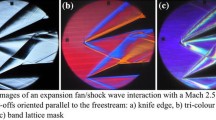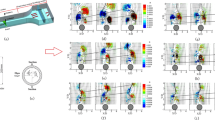Abstract
A modified hydrogen bubble technique is developed for simultaneous three-dimensional flow visualization and surface visualization on bluff bodies. A detailed description of the technique implementation and operating principles is presented. The technique is validated on two geometries: (1) a uniform circular cylinder for ReD = 1,050 and 2,100; and (2) a dual-step cylinder for ReD = 2,100, D/d = 2, and L/D = 0.5. The results demonstrate that flow visualizations effectively capture intricate three-dimensional wake vortex development including the formation of streamwise structures and vortex interactions in the wake of a dual-step cylinder. The surface visualizations capture boundary layer separation and its variation along the span of the models. Moreover, the results reveal complex three-dimensional surface flow patterns, shedding light on the topology of vortical structures forming near dual-step cylinder junctions.
Graphical Abstract












Similar content being viewed by others
References
Abdel-Aal HK, Hussein IA (1993) Parametric study for saline water electrolysis: part III—precipitate formation and recovery of magnesium salts. Int J Hydrogen Energ 18(7):553–556
Baker CJ (1980) The turbulent horseshoe vortex. J Wind Eng Ind Aerod 6:9–23
Ballengee DW, Chen CF (1969) Experimental determination of the separation point of flow around a circular cylinder. Flow Meas Control Sci Ind 1:419–431
Cao S, Ozono S, Tamura Y, Ge Y, Kikugawa H (2010) Numerical simulation of Reynolds number effects on velocity shear flow around a circular cylinder. J Fluid Struct 26:685–702
Clayton BR, Massey BS (1967) Flow visualization in water: a review of techniques. J Sci Instrum 44:1–11
Corke T, Matlis E, Schuele CY, Wilkincon S, Owens L, Balakumar P (2010) Control of stationary cross-flow modes using patterned roughness at Mach 3.5. Seventh IUTAM Symposium on Laminar-Turbulent Transition, IUTAM Bookseries, vol 18., pp 123–128
Dunn W, Tavoularis S (2006) Experimental studies of vortices shed from cylinders with a step change in diameter. J Fluid Mech 555:409–437
Freymuth P (1993) Flow visualization in fluid mechanics. Rev Sci Instrum 64(1):1–18
Guha A (2008) Transport and deposition of particles in turbulent and laminar flow. Annu Rev Fluid Mech 40:311–341
Haugen NEL, Kragset S (2010) Particle impaction on a cylinder in crossflow as function of Stokes and Reynolds numbers. J Fluid Mech 661:239–261
Jenner GA, Longerich HP, Jackson SE, Fryer BJ (1990) ICP-MS–A powerful tool for high-precision trace element analysis in Earth sciences: evidence from analysis of selected USGS reference samples. Chem. Geo 83(1–2):133–148
Kappler M, Rodi W, Szepessy S, Badran O (2005) Experiments on the flow past long circular cylinders in a shear flow. Exp Fluids 38:269–284
Kazi SN, Duffy GG, Chen XD (2010) Mineral scale formation and mitigation on metals and a polymeric heat exchanger surface. Appl Therm Eng 30:2236–2242
Kirk DW, Ledas AE (1982) Precipitate formation during sea water electrolysis. Int J Hydrogen Energy 7(12):925–932
Kleinstreuer C, Feng Y (2013) Computational analysis of non-spherical particle transport and deposition in shear flow with application to lung aerosol dynamics—a review. J Biomech Eng 135:021008
Lamb H (1945) Hydrodynamics, 6th edn. Dover Publications, New York
Langston LS, Boyle MT (1982) A new surface-streamline flow visualization technique. J Fluid Mech 125:53–57
Lu FK (2010) Surface oil flow visualization. Euro Phy J Spec Topics 182:51–63
Merzkirch W (1987) Flow visualization. 2nd (Ed), Academic Press.
Morton C, Yarusevych S (2014) On vortex shedding from low aspect ratio dual step cylinders. J Fluid Struct 44:251–269
Mueller TJ (1980) On the historical development of apparatus and techniques for smoke visualization of subsonic and supersonic flow, AIAA Paper 80-0420-CP
Parnaudeau P, Carlier J, Heitz D, Lamballais E (2008) Experimental and numerical studies of the flow over a circular cylinder at Reynolds number 3900. Phys Fluids 20:085101
Roh SC, Park SO (2003) Vortical flow over the free end surface of a finite circular cylinder mounted on a flat plate. Exp Fluids 34:63–67
Scarano F, Poelma C (2009) Three-dimensional vorticity patterns of cylinder wakes. Exp Fluids 47:69–83
Schraub FA, Kline SJ, Henry J, Runstadler PW Jr, Littell A (1965) Use of hydrogen bubbles for quantitative determination of time-dependent velocity fields in low speed water flows. J. Basic Eng 87(2):429–444
Simpson RL (2001) Junction flows. Annu Rev Fluid Mech 33:415–443
Smith CR, Seal CV, Praisner TJ, Sabatino DR (2000) Hydrogen bubble visualization, invited chapter in flow visualization: techniques and examples. In: Smits AJ, Lim TT (eds) Imperial College Press, London, pp 27–42
Smits AJ, Lim TT (2000) Flow visualization: techniques and examples. Imperial College Press, London
Stucke P, Taipel I (1991) Separation of flow around a circular cylinder at moderate Re-numbers. International Union Theoretical Applied Mechanics, Separated Flows and Jets, pp 751–754
van Oudheusden BW, Nebbeling C, Bannik WJ (1996) Topological interpretation of the surface flow visualization of conical viscous/inviscid interactions. J Fluid Mech 316:115–137
Werle H (1973) Hydrodynamic flow visualization. Annu Rev Fluid Mech 5:361–382
Wissink JG, Rodi W (2008) Numerical study of the near wake of a circular cylinder. Int J Heat Fluid Fl 29:1060–1070
Wu J, Sheridan J, Hourigan K, Soria J (1996) Shear layer vortices and longitudinal vortices in the near wake of a circular cylinder. Exp Therm Fluid Sci 12:169–174
Wu MH, Wen CY, Yen RH, Weng MC, Wang AB (2004) Experimental and numerical study of the separation angle for flow around a circular cylinder at low Reynolds number. J Fluid Mech 515:233–260
Williamson CHK, Wu J, Sheridan J (1995) Scaling of streamwise vortices in wakes. Phys. Fluids 7(10):2307–2309
Acknowledgments
The authors gratefully acknowledge the Natural Sciences and Engineering Research Council of Canada (NSERC) for the funding of this work.
Author information
Authors and Affiliations
Corresponding author
Electronic supplementary material
Below is the link to the electronic supplementary material.
Supplementary material 1 (MPG 19156 kb)
Rights and permissions
About this article
Cite this article
Morton, C., Yarusevych, S. Three-dimensional flow and surface visualization using hydrogen bubble technique. J Vis 18, 47–58 (2015). https://doi.org/10.1007/s12650-014-0219-0
Received:
Revised:
Accepted:
Published:
Issue Date:
DOI: https://doi.org/10.1007/s12650-014-0219-0




